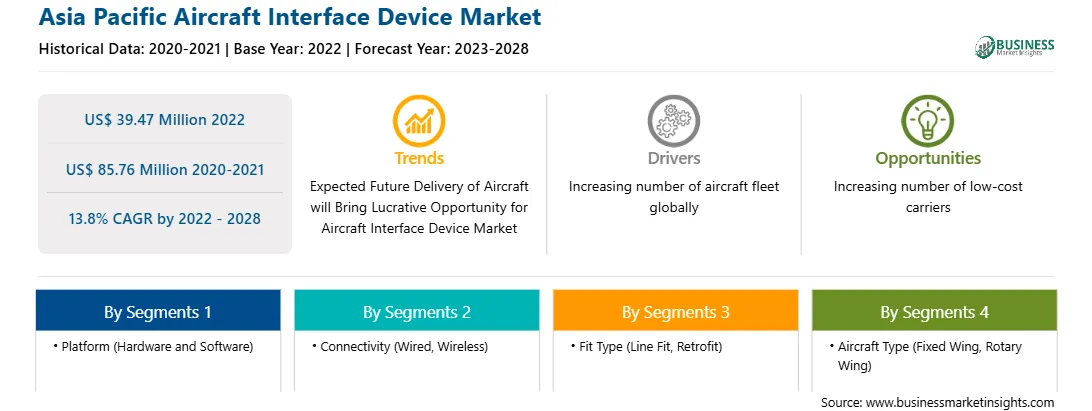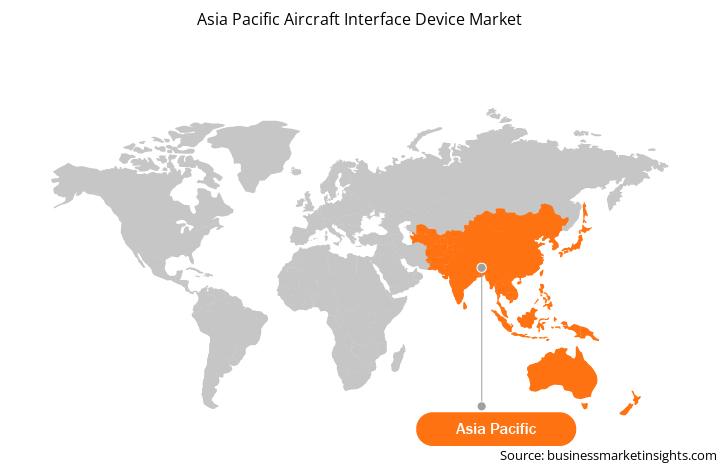The Asia Pacific aircraft interface device market is expected to grow from US$ 39.47 million in 2022 to US$ 85.76 million by 2028. It is estimated to grow at a CAGR of 13.8% from 2022 to 2028.
Increasing Number of Aircraft Fleet Regionally Fuel Asia Pacific Aircraft Interface Device Market
There has been significant growth in the commercial aviation industry in the past decade. The airlines in the developed and developing nations are ordering a high number of aircraft to meet the constantly rising air travel demand. Owing to the continuously growing disposable income among the global population, the need for air travel is also increasing rapidly. Commercial air traffic is anticipated to maintain a constant growth rate, despite various challenges, such as rising aviation fuel costs and technical faults causing accidents. However, these challenges are overcome by the increasing number of passengers, which leads to more aircraft across the region. There has been significant growth in the commercial aviation industry in the past decade. The airlines in the developed and developing nations are ordering a high number of aircraft to meet the constantly rising air travel demand. Owing to the continuously growing disposable income among the global population, the need for air travel is also increasing rapidly. Commercial air traffic is anticipated to maintain a constant growth rate, despite various challenges, such as rising aviation fuel costs and technical faults causing accidents. However, these challenges are overcome by the increasing number of passengers, which leads to more aircraft across the region.
Asia Pacific Aircraft Interface Device Market Overview
The manufacturers and providers of aircraft interface devices in Asia Pacific are expected to experience many opportunities owing to the rapidly growing aircraft manufacturing and MRO service sectors . Asia Pacific has several growing economies leading the growth with various sectors, including aerospace, military & defense, construction, and technology. Many emerging economies in the Asia Pacific region are developing economies and therefore attracting investment from their regulatory bodies to enhance their technologies. This is expected to propel the growth and adoption of advanced technologies to be integrated into aircraft, which drives the demand for aircraft interface devices.
With the escalating air traffic and airline fleet size, Asia Pacific is primed to experience a boom in the aircraft interface device market across the region. The air traffic throughout the region is expected to increase rapidly in the future. Due to these factors, Asia Pacific is expected to showcase the highest growth rate during the forecast period. Companies such as Indigo, Qantas Airlines, South China Airlines, and Singapore Airlines have implemented aircraft interface devices, and the number is likely to increase in the coming years. Further, these companies are also constantly increasing their fleet size, thereby influencing aircraft manufacturing across the region. Thus, such high acquisitions of new aircraft by major commercial airlines operating across the region are expected to increase the demand for AIDS from the aircraft manufacturers.
Asia Pacific Aircraft Interface Device Market Revenue and Forecast to 2028 (US$ Million)
Strategic insights for the Asia Pacific Aircraft Interface Device provides data-driven analysis of the industry landscape, including current trends, key players, and regional nuances. These insights offer actionable recommendations, enabling readers to differentiate themselves from competitors by identifying untapped segments or developing unique value propositions. Leveraging data analytics, these insights help industry players anticipate the market shifts, whether investors, manufacturers, or other stakeholders. A future-oriented perspective is essential, helping stakeholders anticipate market shifts and position themselves for long-term success in this dynamic region. Ultimately, effective strategic insights empower readers to make informed decisions that drive profitability and achieve their business objectives within the market. The geographic scope of the Asia Pacific Aircraft Interface Device refers to the specific areas in which a business operates and competes. Understanding local distinctions, such as diverse consumer preferences (e.g., demand for specific plug types or battery backup durations), varying economic conditions, and regulatory environments, is crucial for tailoring strategies to specific markets. Businesses can expand their reach by identifying underserved areas or adapting their offerings to meet local demands. A clear market focus allows for more effective resource allocation, targeted marketing campaigns, and better positioning against local competitors, ultimately driving growth in those targeted areas.
Asia Pacific Aircraft Interface Device Strategic Insights

Asia Pacific Aircraft Interface Device Report Scope
Report Attribute
Details
Market size in 2022
US$ 39.47 Million
Market Size by 2028
US$ 85.76 Million
Global CAGR (2022 - 2028)
13.8%
Historical Data
2020-2021
Forecast period
2023-2028
Segments Covered
By Platform
By Connectivity
By Fit Type
By Aircraft Type
Regions and Countries Covered
Asia-Pacific
Market leaders and key company profiles
Asia Pacific Aircraft Interface Device Regional Insights

Asia Pacific Aircraft Interface Device Market Segmentation
The Asia Pacific aircraft interface device market is segmented into platform, connectivity, fit type, aircraft type and country.
Based on platform, the Asia Pacific aircraft interface device market is segmented into hardware and software. The hardware segment held a larger share of the Asia Pacific aircraft interface device market in 2022.
Based on connectivity, the Asia Pacific aircraft interface device market is segmented into wired and wireless. The wired segment held a larger share of the Asia Pacific aircraft interface device market in 2022.
Based on fit type, the Asia Pacific aircraft interface device market is segmented into line fit and retrofit. The line fit segment held a larger share of the Asia Pacific aircraft interface device market in 2022.
Based on aircraft type, the Asia Pacific aircraft interface device market is segmented into fixed wing and rotary wing. The fixed wing segment held a larger share of the Asia Pacific aircraft interface device market in 2022.
Based on country, the Asia Pacific aircraft interface device market is segmented into Australia, China, India, Japan, South Korea, and the Rest of Asia Pacific. China dominated the share of the Asia Pacific aircraft interface device market in 2022.
Boeing ; Collins Aerospace ; Honeywell International Inc. ;Teledyne Controls LLC ; Thales Group ; Viasat, Inc. ; and Anuvu are the leading companies operating in the Asia Pacific aircraft interface device market.
The Asia Pacific Aircraft Interface Device Market is valued at US$ 39.47 Million in 2022, it is projected to reach US$ 85.76 Million by 2028.
As per our report Asia Pacific Aircraft Interface Device Market, the market size is valued at US$ 39.47 Million in 2022, projecting it to reach US$ 85.76 Million by 2028. This translates to a CAGR of approximately 13.8% during the forecast period.
The Asia Pacific Aircraft Interface Device Market report typically cover these key segments-
The historic period, base year, and forecast period can vary slightly depending on the specific market research report. However, for the Asia Pacific Aircraft Interface Device Market report:
The Asia Pacific Aircraft Interface Device Market is populated by several key players, each contributing to its growth and innovation. Some of the major players include:
The Asia Pacific Aircraft Interface Device Market report is valuable for diverse stakeholders, including:
Essentially, anyone involved in or considering involvement in the Asia Pacific Aircraft Interface Device Market value chain can benefit from the information contained in a comprehensive market report.